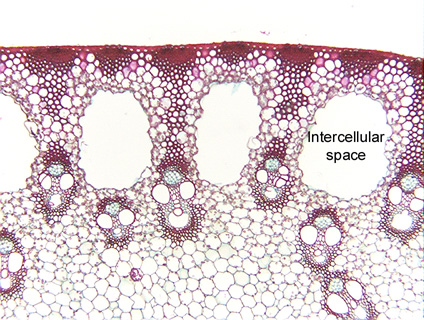 Fig.
3.3-3. Transverse section of stem of sedge (Scirpus). The
large white areas are intercellular spaces
which make this stem light-weight (and thus more buoyant) and permit a more
rapid diffusion of oxygen downward to submerged portions of the stem. The
intercellular spaces are narrow tubes separated from each other by plates of
parenchyma and fiber cells which causes the stem to actually be quite strong
despite being lightly constructed.
Fig.
3.3-3. Transverse section of stem of sedge (Scirpus). The
large white areas are intercellular spaces
which make this stem light-weight (and thus more buoyant) and permit a more
rapid diffusion of oxygen downward to submerged portions of the stem. The
intercellular spaces are narrow tubes separated from each other by plates of
parenchyma and fiber cells which causes the stem to actually be quite strong
despite being lightly constructed.